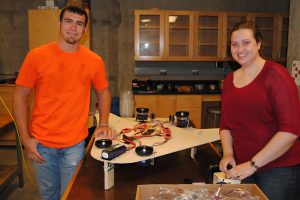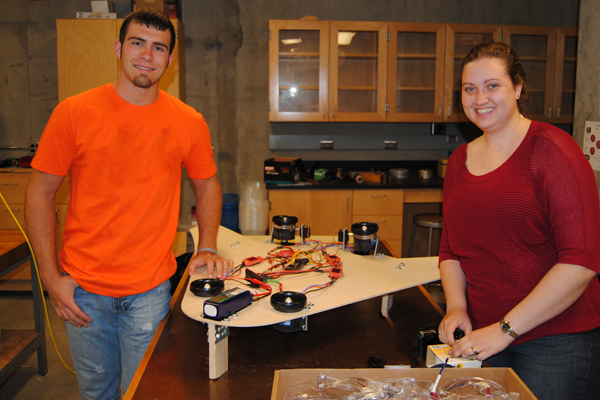
The aerospace department at Iowa State University has taken the pedagogy of teaching “real-world” problems to students into the future. To the year 2040, to be exact. In a senior design project, two collaborative teams of students from Iowa State University and North Carolina A&T State University worked together to design a futuristic vertical take off and landing (VTOL) aircraft. The project and competition were funded by a donation from Boeing. Students were judged on design and technical elements, but the innovation and collaboration they exhibited is what made the capstone class such a success.
Tom Gielda, adjunct professor in aerospace engineering at Iowa State University, literally rewrote the required senior class curriculum to match the demand, both intellectually and creatively, this sort of project requires in industry.
“I don’t come from an academic background. I spent 30 years in industry,” said Gielda. “I have a good feeling of what students should know and what they will see when they get to work. This is a unique opportunity for them to get a taste of what things will be like, in a non-threatening environment.”
In the past, students designed smaller parts of a larger model and worked with classmates of their choosing. This time, students collaborated long-distance and digitally with seniors at North Carolina A&T. The teams utilized social media and other online tools to build and test model MedEvac aircrafts and platforms. The students in North Carolina were in charge of the interior cabin and flight mechanics, while the Iowa State students took the lead on the aerodynamics and propulsion systems.
Gielda’s goal for the students was to push them, all while exposing them to work situations they would face in industry.
“I treated them like we were in business together. The students had to budget their time and money. Models often crashed and had to be rebuilt. This isn’t the easiest thing in the world, especially for kids in college,” Gielda said.
Time was a precious commodity that the students learned to use wisely and efficiently. In industry, Gielda explained, the goal is to reduce design cycle time. Doing so increases the competitiveness of the market, and as a whole, aerospace has been behind the curve on implementing competitive design times.
As part of the project and competition proposed by Boeing, students were required to design and model flight all at once. This took their creations to a level most aerospace industry leaders don’t currently implement.
“The importance of design, historically, has not been stressed enough. The world is getting more competitive, and companies can’t afford long development times. We are exposing the students to something very real in the industry. These students aren’t constrained by the traditional engineering orthodoxies. They brought fresh eyes to the problems and scenarios we presented them,” Gielda said.
The ingenuity and work ethic the students displayed are the kinds of characteristics the aerospace industry is eager to find in future recruits.
“We hope by combining teams of students from Iowa State University and North Carolina A&T that a further appreciation for diversity will emerge – not only ethnic and gender diversity, but also diversity of thought, background, skills, and experience. Our company and industry needs talented engineers to help shape the future of aerospace,” said Matt Daniels, manager of global corporate citizenship and higher education for The Boeing Company. “We hope that competitions like this offer a rich learning experience that encourages these bright student to stay on the path towards their engineering degrees and ultimately pursue technical jobs to support the critical needs that engineers can fill.”
For students, the project and collaboration was time consuming, challenging, and rewarding.
“I was most surprised by the level of detail that went into the project from both teams. It didn’t seem like much time to put everything together, but looking back, I can see how much we accomplished and how much more we will continue to grow and learn,” said Alex Carr. Carr graduated in May and went straight to work as a design engineer for Emerson Fisher.
Other students saw the new design approach as an appropriate capstone to their collegiate careers, and a helpful step towards their futures.
“This project brought together all the classes that I had to take leading up to senior design. It was the first class that I did not look at a part of an airplane but had to look at the big picture and how all the smaller pieces fit together to make the larger project work correctly. After graduation I want to work in research for either a university or NASA,” said Christine Jensen.
Dr. Richard Wlezien, Professor and aerospace engineering department chair at Iowa State University, was impressed with the student teams, and satisfied with the overall success of the project.
“We are grateful to Boeing for sponsoring this partnership with North Carolina A&T. It has been a unique experience from both a technical and social perspective. In the end, all our students experienced the thrills and challenges of making a team function to address a complex systems problem. This experience is a high-fidelity model of what they will see in their future career, and everyone benefits from its success,” said Wlezien.
Through collaboration and design innovation, students, faculty, and industry were allowed to challenge the aerospace manufacturing norm. The competition gave students license to step outside the industry conventions and prove that the next generation of engineers is ready and willing to take their industry to the next level.
“Both ISU and NCA&T students and faculty dedicated a lot of time and effort to this project. Although it was a competition, everyone emerged a winner. It’s a success story we hope to replicate with other university partners,” Daniels said.
